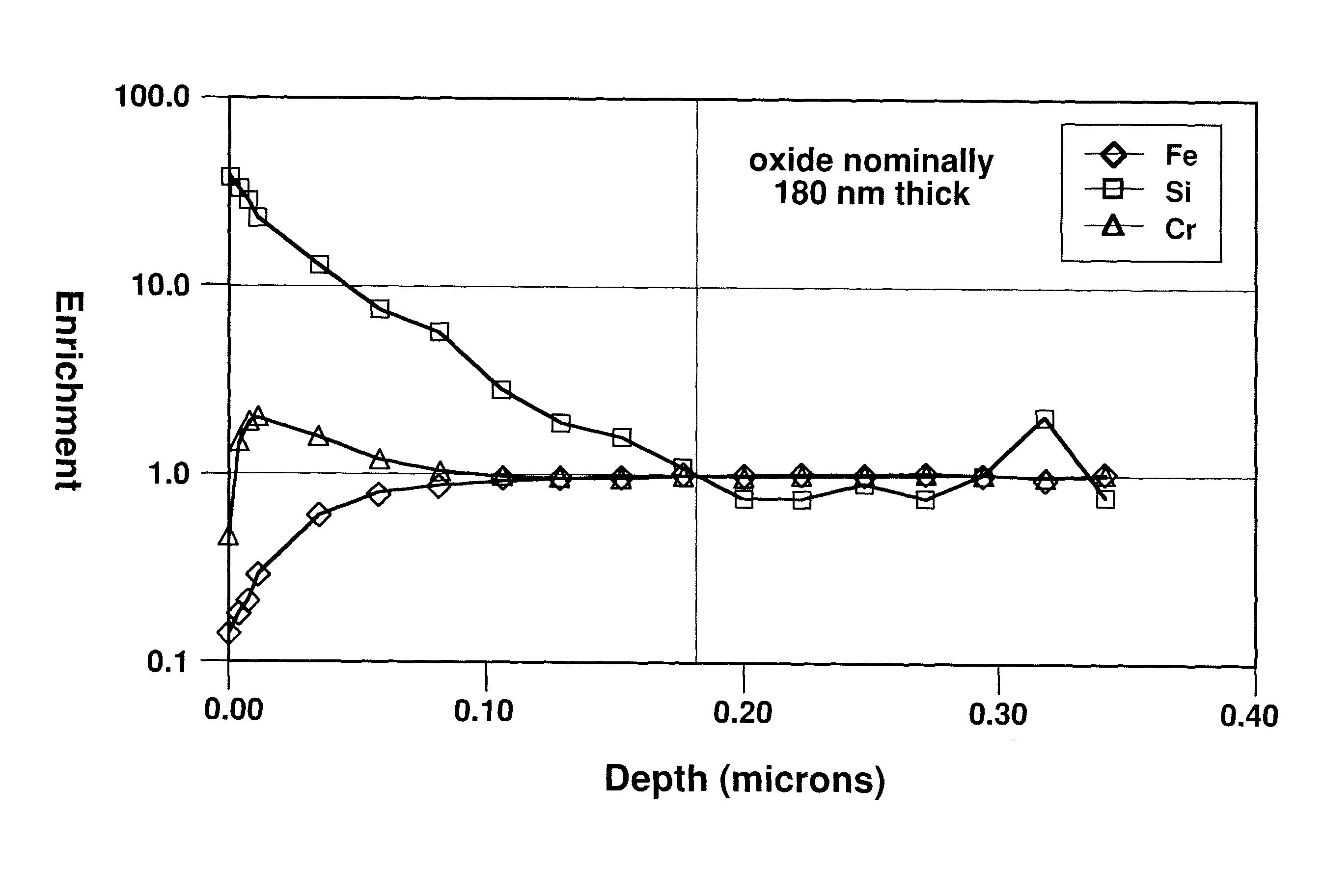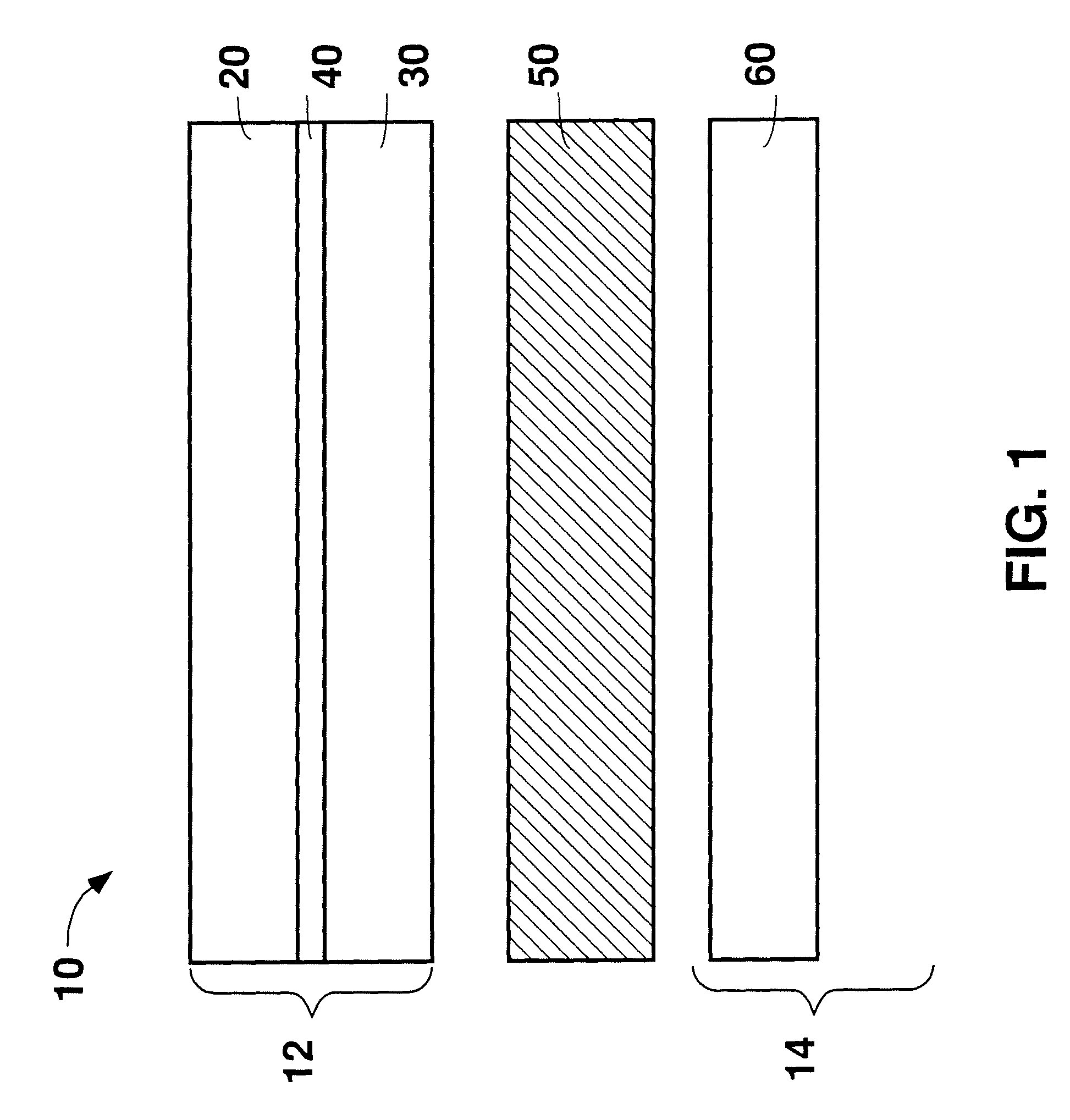Method for reducing formation of electrically resistive layer on ferritic stainless steels
a technology of ferritic stainless steel and resistive layer, which is applied in the direction of sustainable manufacturing/processing, heat treatment apparatus, final product manufacturing, etc., can solve the problems of brittle lacrosub>3 /sub>ceramic, difficult to fabricate, and liquid electrolytes, etc., to achieve the effect of reducing or eliminating
- Summary
- Abstract
- Description
- Claims
- Application Information
AI Technical Summary
Benefits of technology
Problems solved by technology
Method used
Image
Examples
example 1
[0046]A 0.5 mm thick sample panel of AISI Type 430 stainless steel, which nominally includes 0.4 weight percent silicon, was annealed in a furnace chamber having a hydrogen atmosphere including a small concentration of water vapor, along with incidental impurities. The dew point of the hydrogen atmosphere was not measured but was believed to be in the range of about −20° C. to 0° C. The panel was heated in the furnace chamber at approximately 1010° C. for 30 minutes time-at-temperature (as measured by a contact thermocouple). The sample panel emerged from the furnace after heating with a dull surface tint, indicating that a relatively thick silica-containing layer (scale) had formed on the panel surface. The test panel was then examined using a scanning Auger microprobe having a depth profiling capability (via an ion sputtering gun). FIG. 3 illustrates the Auger compositional depth profile of the stainless steel sample, normalized to measure bulk composition. FIG. 3 plots relative e...
example 2
[0052]Several coupons of AISI Type 441 stainless steel having the alloy chemistry shown in Table 2 (shown in weight percentages) were prepared. Several of the coupons were heated at 1850° F. (1010° C.) in a mesh-belt furnace in a hydrogen atmosphere including a small concentration of water vapor. The water vapor concentration corresponded to a dew point of nominally −20° C. The coupons were within the heating zone of the furnace for approximately 30 minutes. The heat treatment produced a silica scale on the surface of the heated coupons, and these coupons are referred to in this example as the “pre-oxidized” samples. Other coupons of the same steel were not subjected to the heat treatment and are referred to in this example as “untreated” samples. It is known to form a homogenous single phase manganese cobaltite spinel (“MC”) coating on the surfaces of ferritic stainless steel SOFC interconnects to protect the fuel cells from chromium poisoning and to improve interconnect stability....
example 3
[0056]Coupons of the following ferritic stainless steels used in interconnect applications were prepared: AISI Type 430 (UNS S43000); Type 439 (UNS S43035); Type 441 (UNS S44100); and E-BRITE® alloy (UNS S44627). Coupons of Types 430, 439, and 441 were pre-oxidized to remove silicon from sub-surface regions of the coupons using the technique described above in Example 2 (i.e., 1010° C. for 30 minutes). Other coupons were left untreated. The coupons were then heated at 800° C. in simulated anode gas (SAG) for a time in excess of 1000 hours, and the normalized weight change (mg / cm2) of each sample was determined periodically. The SAG consisted of 4 vol. % hydrogen, 3 vol. % water vapor, and balance argon, and simulated the fuel side environment within a SOFC. The oxygen content within the SAG was low, but sufficient to oxidize the samples.
[0057]FIG. 6 is a plot of the test results. Pre-oxidation (i.e., desiliconization) was uniformly beneficial to the samples heated in the SAG. The re...
PUM
| Property | Measurement | Unit |
|---|---|---|
| partial pressure | aaaaa | aaaaa |
| weight percent | aaaaa | aaaaa |
| temperature | aaaaa | aaaaa |
Abstract
Description
Claims
Application Information
 Login to View More
Login to View More - R&D
- Intellectual Property
- Life Sciences
- Materials
- Tech Scout
- Unparalleled Data Quality
- Higher Quality Content
- 60% Fewer Hallucinations
Browse by: Latest US Patents, China's latest patents, Technical Efficacy Thesaurus, Application Domain, Technology Topic, Popular Technical Reports.
© 2025 PatSnap. All rights reserved.Legal|Privacy policy|Modern Slavery Act Transparency Statement|Sitemap|About US| Contact US: help@patsnap.com



